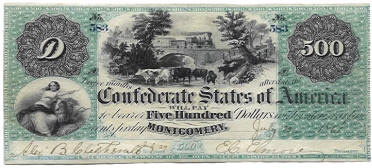|
|
Two Billion Dollars in Confederate Paper
Money
The Confederate States of
America currency was first issued into circulation in April, 1861,
when the Confederacy was only two months old, and on the eve of the
outbreak of the Civil War.
Notes were ultimately issued in $.10, $.50, $1, $2, $5, $10, $20,
$50, $100, $500, and $1000 denominations with a variety of designs,
issuers and redeemable obligations. The total amount of currency
issued under the various acts of the Confederate Congress totaled
$1.7 billion. Bills were released in 72 different note "types" in
seven "series" between 1861 and 1865.
At first, Confederate currency was accepted throughout the South as
a medium of exchange with high purchasing power. As the conflict
progressed, however, confidence in the ultimate success waned, the
amount of paper money increased, and their dates of redemption were
extended further into the future. The inevitable result was
depreciation of the currency, and soaring prices characteristic of
inflation. For example, by the end of the conflict, a cake of soap
could sell for as much as $50 and an ordinary suit of clothes was
$2,700. By war's end, the currency became virtually worthless as a
medium of exchange.
Owing to the vast number of Confederate notes and varietals, not to
mention the fact that Southern states and banks could issue their
own notes, counterfeiting was a major problem for the Confederacy.
The average Southern citizen would be hard pressed to tell a real
note from a fake. Many of these contemporary counterfeits are known
today and can be worth as much to a collector as a real note. |

